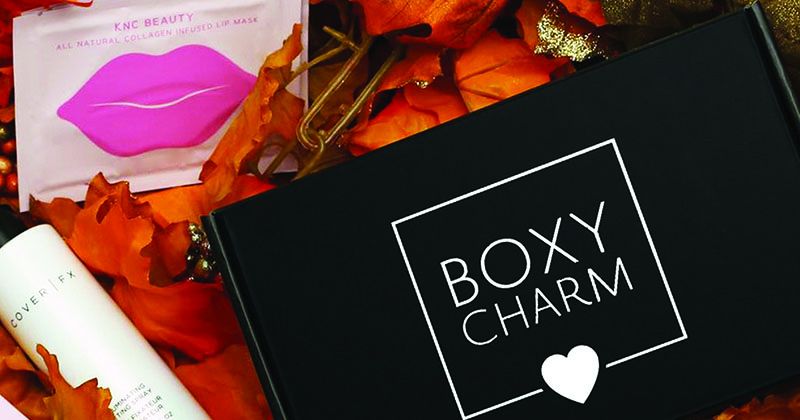The subscription market continues to gain momentum in the retail space. In the past five years, McKinsey and Co. reports that the subscription e-commerce marketplace has grown by more than 100 percent. Direct-to-consumer subscription programs are found in every corner of the marketplace—from bathroom care (Dollar Shave Club, Quip) and clothing (Stitch Fix), to food (Hello Fresh, Blue Apron) and toys (Loot Crate). Even traditional retailers like Target, Walmart, Ann Taylor, and Gap are beginning to get in on the action.
Food and beauty products are considered the hottest industries for subscription boxes. One of the top beauty brands is Boxy Charm, which ships about five monthly themed makeup, color cosmetics, and other beauty products to members’ doors. It recently was awarded the 2018 Best Customer Experience award from the Subscription Trade Association.
According to CEO and founder Joe Martin, the company works to understand the unique preferences of members—who it calls Charmers—and improve customization over time. We recently spoke with Martin about how Boxy Charm stays ahead in a fast-moving industry.
Customer Strategist: Boxy Charm recently won the ‘Best Customer Experience’ award at the Subscription Summit. In an industry that focuses on the individual customer experience, how do you set yourself apart?
Joe Martin: It depends on how you see yourself and what you’re looking for. If your vision is to grow revenue per member, then you’re going to try to upsell them and expect to break some things along the way. Our core value is different.
Our main company goal is to grow horizontally with our number of members, and to do so we have a couple of pillars. One of these is customer service and experience. So customer experience would basically be the big “why.” Like why would someone advocate for Boxy Charm when things go wrong, or why would a member go out of their way to promote Boxy Charm?
The products we deliver in the box sell themselves, and we wrap them in a well-organized marketing campaign to deliver a unique experience, so charmers can share an experience and share the box.
Once such campaign showed people’s instant gratification reactions and the payoff on different skin tones (with photos and videos). Each communication platform has its own unique approach to make it as organic as possible. And that’s what we keep drilling every day. This is our secret recipe. It’s a lot of things that must play together and have the right energy. So it’s more of a mindset. Where do you want to be and how do you want to be there? That’s the experience.
And in terms of our future vision, it’s introducing better artificial intelligence, which will help us segment the boxes better for finding the people from the moment they subscribe. This includes any recommendations or suggestion tools we use help identify users’ preferences. We can profile members as they subscribe and use a look-alike from current members to determine what products to place in the box. This is obviously only one point of many. The options are endless.
CS: What’s your take on the rapid growth of the subscription marketplace?
JM: Now there are two types of subscriptions. There is replenishment (think Dollar Shave Club) and then there’s discovery. We fall under the discovery concept. But I think the interesting part between the two is that it’s a matter of how you work with it. There are advantages and disadvantages for both. Coming from discovery, it helps a lot when it comes down to your user-generated content helping you grow. The space now is obviously expanding and Boxy Charm grew last year by more than 150 percent.
CS: What steps do you take to ensure that members have a great experience and will keep coming back?
JM: You always have to reinvent yourself through trial and error, and changes are welcome even if they are last minute. We always ask where the current is flowing, so we don’t swim against it. The space is dynamic, so we embrace it and structure it to work around what the environment dictates. For example, from day one of Boxy Charm we learned that some products are controversial, meaning the product may not be a safe bet, or be a color that some customers may not like. Once segmented, we plan to place eccentric colors with Charmers who enjoy those types of products. So sometimes we modify the box within the same month and split the quantity at the last minute. You don’t need to reformulate everything, but just those little tweaks every time can make the difference and surprise members every month.
In order for you to get the right product, you have to ask yourself about all the lines of innovation, needs, and questions. We cannot keep the same experience and expect people to be excited every time for the same thing. That’s why we have a theme every month, which changes the experience.
Consistency is the death of every subscription box. You have to stay agile and ahead of the curve. This means being paranoid, on our toes, and working harder than anyone else. There is no magic formula, no data, or trick, just a lot of hard work.
CS: What is the biggest challenge you see in the B2C subscription space?
JM: I think any subscription base has two challenges. One is churn and the second is outside competition. And this internal churn comes from voluntary and involuntary factors.
The voluntary churn is people just opting out. You’ll have a percentage every month of people wanting to drop because they are just trying to save money, or it wasn’t for them. But the involuntary, the people who stop paying, is a challenge as we keep growing. If you have a certain percentage of voluntary and involuntary churn that’s kind of stagnant and you can move it south or north just a little bit, but it is what it is. As you keep growing those numbers are going higher and higher. Then the challenge comes from the fact that your marketing efforts, after a while, have to be substantially harder in order to cover that churn.
And that’s where our philosophy comes into place. We have to grow based on our members, so if we keep growing we would grow at the same rate as our members refer other members. That’s how we fight churn, but it’s a challenge.
The second part is outside competition. Today you have hundreds of subscription boxes and it’s just imminent that everyone wants a piece of the pie. On top of that there are also big competitors like Sephora and Macy’s entering the market. But we’ve learned that it’s not necessarily driving the growth down. In fact, it actually helps us grow by bringing more awareness to the whole space. But when you have competitors come in every day and you’re trying to stay the star of the show, it’s a challenge.
CS: What do you think it takes to be an innovative brand in 2018?
JM: To stay on top, innovation is the key. And it’s all about speed to market. The big brands have a very long lead time from concept to execution because they have to get approvals to place the product in department stores. The direct-to-consumer companies are connected with influencers that can deploy products (and experiences)quickly. The ones that will execute faster will win.
Some may think just because you have an innovative product it’s enough. But you need to know the lay of the land in the new social media world. You need to know how to create awareness and engagement in the most economical and positive way.






